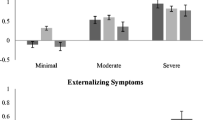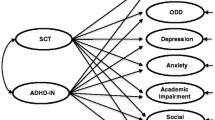Abstract
The objective of the current study was to evaluate how the inclusion of 3 Sluggish Cognitive Tempo (SCT) symptoms in Attention-Deficit/Hyperactivity Disorder (ADHD) diagnostic criteria influences the external validity of the ADHD subtypes. The sample comprised 228 children (166 boys, 62 girls) ranging in age from 5–18 years who were referred to clinics for attentional, behavioral, and/or learning problems and diagnosed with DSM-IV ADHD (124 Combined type, 81 Inattentive type, 23 Hyperactive-Impulsive type). Parent ratings of ADHD symptoms were obtained using the Emory Combined Rating Scale (ECRS), which assesses symptoms of the common DSM-IV childhood psychiatric disorders. Regression analyses incorporating planned comparisons were conducted to examine how the inclusion of SCT symptoms affects differences among ADHD subtypes on several external validity indicators (i.e., gender, age-of-onset, and overlapping conditions). The regression analyses did not yield any significant differences in gender ratios, mean age-of-onset, or overlapping externalizing or internalizing problems when the ADHD Inattentive type was subdivided into high- versus low-SCT groups. In conclusion, the current results suggest that the inclusion of parent-reported SCT symptoms in the ADHD diagnostic criteria has limited utility for isolating diagnostically meaningful subgroups of the Inattentive type or for enhancing the external validity of the ADHD subtypes in clinic-referred samples.
Similar content being viewed by others
References
American Psychiatric Association. (1994). Diagnostic and Statistical Manual of Mental Disorders (4th ed.). Washington, D.C.: American Psychiatric Association.
American Psychiatric Association. (2000). Diagnostic and Statistical Manual of Mental Disorders, Text Revision (4th ed.). Washington, D.C.: American Psychiatric Association.
Barkley, R. A. (2001). The inattentive type of ADHD as a distinct disorder: What remains to be done. Clinical Psychology: Science and Practice, 8, 489–493.
Barkley, R. A. DuPaul, G. J. & McMurray, M. B. (1990). Comprehensive evaluation of attention deficit disorder with and without hyperactivity as defined by research criteria. Journal of Consulting and Clinical Psychology, 58, 775–789.
Barkley, R. A. DuPaul, G. J. & McMurray, M. B. (1991). Attention deficit disorder with and without hyperactivity: Clinical response to three does of methylphenidate. Pediatrics, 87, 519–531.
Bauermeister, J. J. Matos, M. Reina, G. Salas, C. C. Martinez, J. V. Cumba, E. et al. (2005). Comparison of the DSM-IV combined and inattentive types of ADHD in a school-based sample of Latino/Hispanic children. Journal of Child Psychology and Psychiatry, 46(2), 166–179.
Baumgaertel, A. Wolraich, M. L. & Dietrich, M. (1995). Comparison of diagnostic criteria for attention deficit disorders in a German elementary school sample. Journal of the American Academy of Child and Adolescent Psychiatry, 34, 629–638.
Carlson, C. L. & Mann, M. (2000). Attention-deficit/hyperactivity disorder, predominantly inattentive subtype. Child and Adolescent Psychiatric Clinics of North America, 9(3), 499–510.
Carlson, C. L. & Mann, M. (2002). Sluggish cognitive tempo predicts a different pattern of impairment in the attention deficit hyperactivity disorder, predominantly inattentive type. Journal of Clinical Child and Adolescent Psychology, 31(1), 123–129.
Carlson, C. L. Shin, M. & Booth, J. (1999). The case for DSM-IV subtypes in ADHD. Mental Retardation and Developmental Disabilities Research Reviews, 5, 199–206.
Chhabildas, N. Pennington, B. & Willcutt, E. (2001). A comparison of the neuropsychological profiles of the DSM-IV subtypes of ADHD. Journal of Abnormal Child Psychology, 29, 529–540.
Coffman, J. K. Guerin, D. W. & Gottfried, A. W. (2006). Reliability and validity of the parent-child relationship inventory (PCRI): Evidence from a longitudinal cross-informant investigation. Psychological Assessment, 18(2), 209–214.
Cohen, J. Cohen, P. West, S. G. & Aiken, L. S. (eds). (2003). Applied multiple regression/ correlation analysis for the behavioral sciences (3rd ed.). Mahwah: Lawrence Erlbaum Associates, Publishers.
Faraone, S. V. Biederman, J. & Friedman, D. (2000). Validity of DSM-IV subtypes of Attention-deficit/hyperactivity disorder: A family study perspective. Journal of the American Academy of Child and Adolescent Psychiatry, 39(3), 300–307.
Faraone, S. V. Biederman, J. Weber, W. & Russell, R. L. (1998). Psychiatric, neuropsychological, and psychosocial features of DSM-IV subtypes of Attention-deficit/ hyperactivity disorder: Results from a clinically referred sample. Journal of the American Academy of Child and Adolescent Psychiatry, 37(2), 185–193.
Frick, P. J. Lahey, B. B. Applegate, B. Kerdyck, L. Ollendick, T. Hynd, G. W. et al. (1994). DSM-IV field trials for the disruptive behavior disorders: Symptom utility estimates. Journal of the American Academy of Child and Adolescent Psychiatry, 33, 529–539.
Gaub, M. & Carlson, C. (1997). Behavioral characteristics of DSM-IV ADHD subtypes in a school-based population. Journal of Clinical Child Psychology, 21, 103–111.
Gizer, I. R. Waldman, I. D. Abramowitz, A. Barr, C. L. Feng, Y. Wigg, K. G. et al. (2008). Relations between multi-informant assessments of ADHD symptoms, DAT1, and DRD4. Journal of Abnormal Psychology, 117(4), 869–880.
Gregory, A. M. Eley, T. C. & Plomin, R. (2004). Exploring the association between anxiety and conduct problems in a large sample of twins aged 2–4. Journal of Abnormal Child Psychology, 32(2), 111–122.
Hartman, C. A. Willcutt, E. G. Rhee, S. H. & Pennington, B. F. (2004). The relation between sluggish cognitive tempo and DSM-IV ADHD. Journal of Abnormal Child Psychology, 32(5), 491–503.
Hinshaw, S. P. Carte, E. T. Sami, N. Treuting, J. J. & Zupan, B. A. (2002). Preadolescent girls with attention-deficit/hyperactivity disorder: II. Neuropsychological performance in relation to subtypes and individual classification. Journal of Consulting and Clinical Psychology, 70, 1099–1111.
Krueger, R. F. (1999). The structure of common mental disorders. Archives of General Psychiatry, 56, 921–926.
Lahey, B. B. Applegate, B. McBurnett, K. Biederman, J. Greenhill, L. Hynd, G. W. et al. (1994). DSM-IV field trials for Attention Deficit Hyperactivity Disorder in children and adolescents. American Journal of Psychiatry, 151(11), 1673–1685.
Lahey, B. B. Pelham, W. E. Schaughency, E. A. Atkins, M. S. Murphy, H. A. Hynd, G. W. et al. (1988). Dimensions and types of attention deficit disorder. Journal of the American Academy of Child and Adolescent Psychiatry, 27(3), 330–335.
Lahey, B. B. Schaughency, E. A. Frame, C. L. & Strauss, C. C. (1985). Teacher ratings of attention problems in children experimentally classified as exhibiting attention deficit disorder with and without hyperactivity. Journal of the American Academy of Child and Adolescent Psychiatry, 24(5), 613–616.
Lahey, B. B. Schaughency, E. A. Hynd, G. W. Carlson, C. L. & Nieves, N. (1987). Attention deficit disorder with and without hyperactivity: Comparison of behavior characteristics of clinic-referred children. Journal of the American Academy of Child and Adolescent Psychiatry, 26(5), 718–723.
Lahey, B. B. Waldman, I. D. Hankin, B. L. Applegate, B. Loft, J. D. & Rick, J. (2004). The structure of child and adolescent psychopathology: Generating new hypotheses. Journal of Abnormal Psychology, 113(3), 358–385.
Lahey, B. B. & Willcutt, E. (2002). The validity of attention-deficit/hyperactivity disorder among children and adolescents. In P. S. Jensen & J. R. Cooper (Eds.), Diagnosis and treatment of attention deficit hyperactivity disorder: An evidence-based approach (pp. 1–23). New York: Civic Research Institute.
McBurnett, K. (1997). Attention-deficit/hyperactivity disorder: Review of diagnostic issues. In T. Widiger, A. Frances, H. Pincus, R. Ross, M. First & W. Davis (Eds.), DSM-IV sourcebook (pp. 111–143). Washington, DC: American Psychiatric Association.
McBurnett, K. Pfiffner, L. J. & Frick, P. J. (2001). Symptom properties as a function of ADHD type: An argument for continued study of sluggish cognitive tempo. Journal of Abnormal Child Psychology, 29(3), 207–213.
Milich, R. Balentine, A. C. & Lynam, D. R. (2001). ADHD combined type and ADHD predominantly inattentive type are distinct and unrelated disorders. Clinical Psychology: Science and Practice, 8(4), 463–506.
Morgan, A. E. Hynd, G. W. Riccio, C. A. & Hall, J. (1996). Validity of DSM-IV ADHD predominantly inattentive and combined types: Relationship to previous DSM diagnoses/ subtype differences. J Am Acad Child Adolesc Psychiatry, 35, 325–333.
Nigg, J. T. Blaskey, L. Stawicki, J. & Sachek, J. (2004). Evaluating the endophenotype model of ADHD neuropsychological deficit: results for parents and siblings of children with ADHD combined and inattentive subtypes. Journal of Abnormal Psychology, 113, 614–625.
Paternite, C. E. Loney, J. & Roberts, M. A. (1996). A preliminary validation of subtypes of DSM-IV attention-deficit/hyperactivity disorder. Journal of Attention Disorders, 1, 70–86.
Rowe, D. C. Stever, C. Giedinghagen, L. N. Gard, J. M. C. Cleveland, H. H. Terris, S. T. et al. (1998). Dopamine DRD4 polymorphism and attention deficit hyperactivity disorder. Molecular Psychiatry, 3, 419–426.
Skansgaard, E. P. & Burns, G. L. (1998). Comparison of DSM-IV ADHD combined and predominantly inattentive types: Correspondence between teacher ratings and direct observations of inattentive, hyperactivity/impulsivity, slow cognitive tempo, oppositional defiant, and overt conduct disorder symptoms. Child and Family Behavior Therapy, 20, 1–14.
Stawicki, J. A. Nigg, J. T. & van Eye, A. (2006). Family psychiatric history evidence on the nosological relations of DSM-IV ADHD combined and inattentive subtypes: new data and meta-analysis. Journal of Child Psychology and Psychiatry, 47(9), 935–945.
Stein, M. A. Sarampote, C. S. Waldman, I. D. Robb, A. S. Conlon, C. Pearl, P. L. et al. (2003). A dose- response study of OROS methylphenidate in children with attention-deficit/hyperactivity disorder. Pediatrics, 112(5), e404–e413.
Todd, R. D. Rasmussen, E. R. Wood, C. Levy, F. & Hay, D. A. (2004). Should sluggish cognitive tempo symptoms be included in the diagnosis of attention-deficit/hyperactivity disorder? Journal of the American Academy of Child and Adolescent Psychiatry, 43(5), 588–597.
Waldman, I. D. Rowe, D. C. Abramowitz, A. Kozel, S. T. Mohr, J. H. Sherman, S. L. et al. (1998). Association and linkage of the dopamine transporter gene and attention-deficit hyperactivity disorder in children. American Journal of Human Genetics, 63, 1767–1776.
Wolraich, M. L. Hanah, J. N. Pinnock, T. Y. Baumgaertel, A. & Brown, J. (1996). Comparison of diagnostic criteria for attention-deficit hyperactivity disorder in a county wide sample. Journal of the American Academy of Child and Adolescent Psychiatry, 35, 319–324.
Author information
Authors and Affiliations
Corresponding author
Additional information
Kelly M. Harrington’s contribution to the writing of this manuscript was supported, in part, by NIMH training grant T32MH019836 (awarded to Terence M. Keane).
The project described herein was supported in part by NIMH grant K01-MH01818 (awarded to Irwin D. Waldman).
Rights and permissions
About this article
Cite this article
Harrington, K.M., Waldman, I.D. Evaluating the Utility of Sluggish Cognitive Tempo in Discriminating Among DSM-IV ADHD Subtypes. J Abnorm Child Psychol 38, 173–184 (2010). https://doi.org/10.1007/s10802-009-9355-8
Published:
Issue Date:
DOI: https://doi.org/10.1007/s10802-009-9355-8




